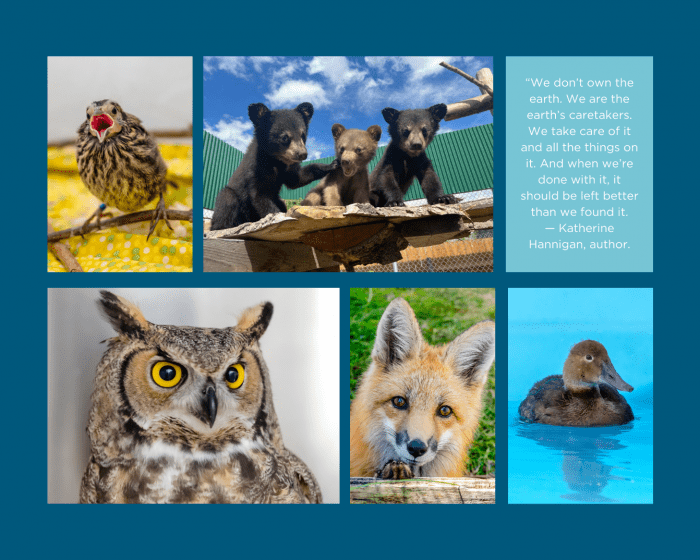Since 1993, Alberta Institute for Wildlife Conservation (AIWC) has been a champion for injured and orphaned wildlife through rescue, rehabilitation and release. Since our founding, we have admitted more than 38,000 animals into care. We believe our responsibility to wildlife includes an educational component that emphasizes the importance of environmental protection, and as such, AIWC offers engaging public education programs to inform all ages of the importance of wildlife to our ecosystem and way of life.
As a trusted Canadian-registered charity, we are permitted by federal and provincial governments to care for wildlife in need. In addition, we are an accredited veterinary hospital through the Alberta Veterinary Medical Association, which allows us to provide high standards of care to our wildlife patients. We are funded entirely by donations.
AIWC is open year-round to care for wildlife in need. Our mission is supported by full-time staff, part-time staff, an incredible team of 125+ volunteers, and over 250 active memberships. Spring and summer are the busiest seasons for animal care.
AIWC is located on and services all human and wild residents of Treaty 7 territory. As treaty people, we believe we have a responsibility to care for the lands we inhabit, along with all creatures living on the land with us.
At AIWC, we believe that equity, diversity, inclusion, and accessibility (EDIA) are essential to achieving our mission of preserving and protecting Alberta’s wildlife and their habitats. We recognize that systemic discrimination and biases have historically impacted marginalized groups’ ability to access wildlife education, conservation, and related opportunities. AIWC is committed to creating an environment that fosters respect, dignity, and safety for everyone, regardless of their race, ethnicity, gender, sexual orientation, age, religion, ability, or socio-economic background.
Our Vision
Preserving the legacy of wildlife.
Our Mission
AIWC is committed to the rescue, rehabilitation, and release of injured and orphaned wildlife. We provide expert advice and education that fosters an appreciation of wildlife.
CORE VALUES
STEWARDSHIP –
At AIWC we are responsible stewards of the organization securing the growth, sustainability, and legacy of wildlife.
ACCOUNTABILITY –
At AIWC we are accountable to our wildlife and human communities, including our donors, members, staff and volunteers, industry colleagues, and ourselves.
COMPASSION –
At AIWC we are fostering the co-existence with, and compassionate and ethical treatment of wildlife.
IMPACT –
At AIWC we are maximizing our impact through education, outreach, and social awareness.
OUR PROGRAMS
WILDLIFE EDUCATION
We believe in developing awareness through education. Through outreach programming, we’re working to create strong co-existence between Albertans and wildlife. In 2024, we provided wildlife education to over 5,300 members of the community.
WILDLIFE RESCUE & HOTLINE
Annually, we take over 8,000 wildlife-related calls, providing assistance and information to support the well-being and, in some cases, the survival of animals.
WILDLIFE REHABILITATION
95% of the animals we see are admitted due to human conflict in some way, such as vehicular collision, window strike, and cat and dog attacks. Over 2,000 animals have been cared for at AIWC so far in 2025.
AIWC provides services to all populations across Alberta, but predominantly in the city of Calgary. In 2024, 71% of our patients were admitted from within the city of Calgary. In addition, the majority of calls to our Wildlife Hotline in 2024 came from the city of Calgary. Our volunteers predominantly come from Calgary, Airdrie, and Cochrane.
—
A gift to AIWC provides injured and orphaned Alberta wildlife a chance to be rescued, rehabilitated, and released back into the wild. As we are funded entirely by donations, each gift from our generous donors gives wildlife a chance to survive and thrive in the wild.
With a donation today, you will join other supporters who believe that wildlife is critical to our survival and the health of our environment. Our supporters believe we have the responsibility to help wildlife, as 95% of animals admitted to AIWC are injured or orphaned due to human activities.
If you choose to give monthly, your gift will make a bigger impact on wildlife that needs it the most. You’ll rest assured that your gift will provide ongoing daily care for injured and orphaned wildlife.
Volunteer: AIWC depends on an army of dedicated and passionate volunteers to assist the staff members with the operation of our wildlife hospital. Volunteering is a truly rewarding experience, and even tasks such as floor-mopping are more enjoyable when you know you’re helping wildlife and are surrounded by such magnificent creatures.
Help is needed in various roles and at various times of the year. Spring and summer are our “peak” seasons; however, we rely heavily on 115+ active volunteers year-round to keep our centre operating. Visit AIWC: Volunteer for more information on volunteering with AIWC.

Are you a Calgary Foundation Fundholder?
Contact Info
Alberta Institute for Wildlife Conservation
Robyn Cunningham-Dunlop - Acting Executive Director
403.946.2361
Email